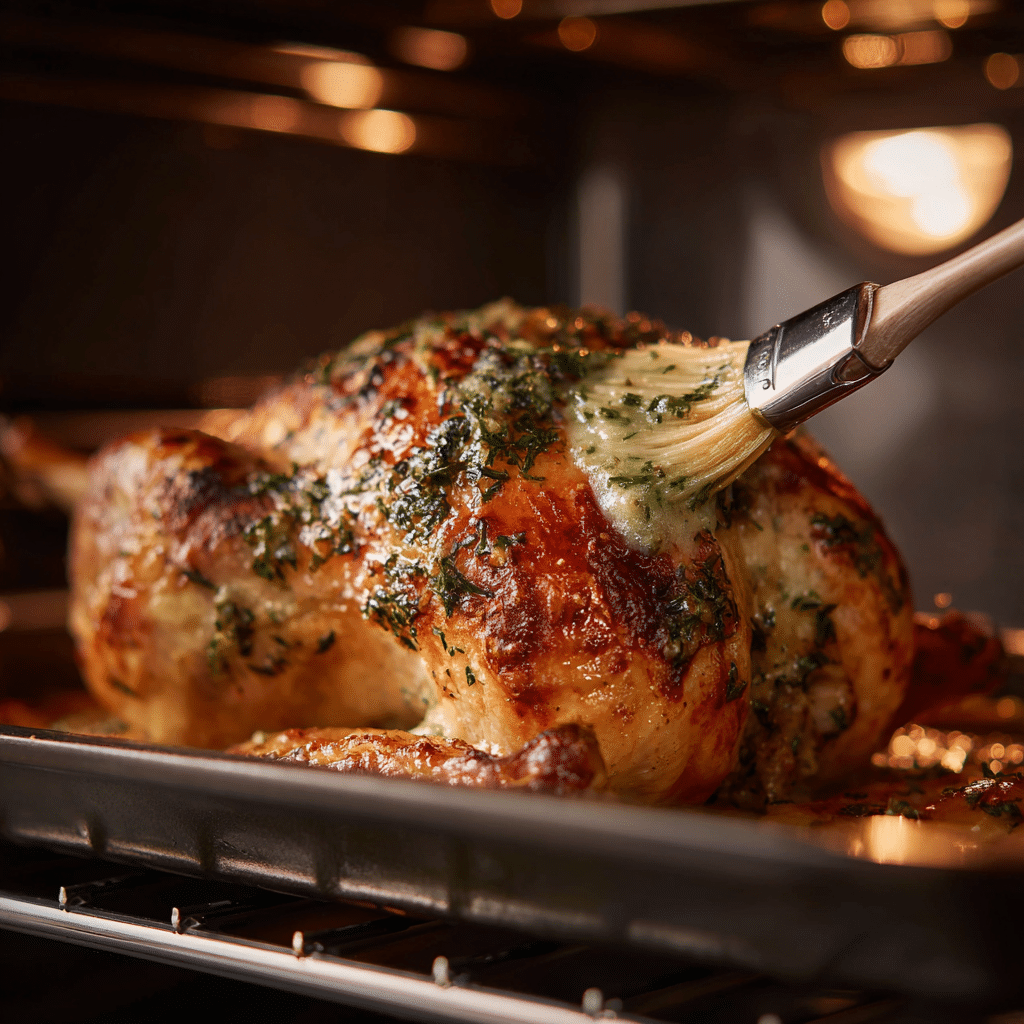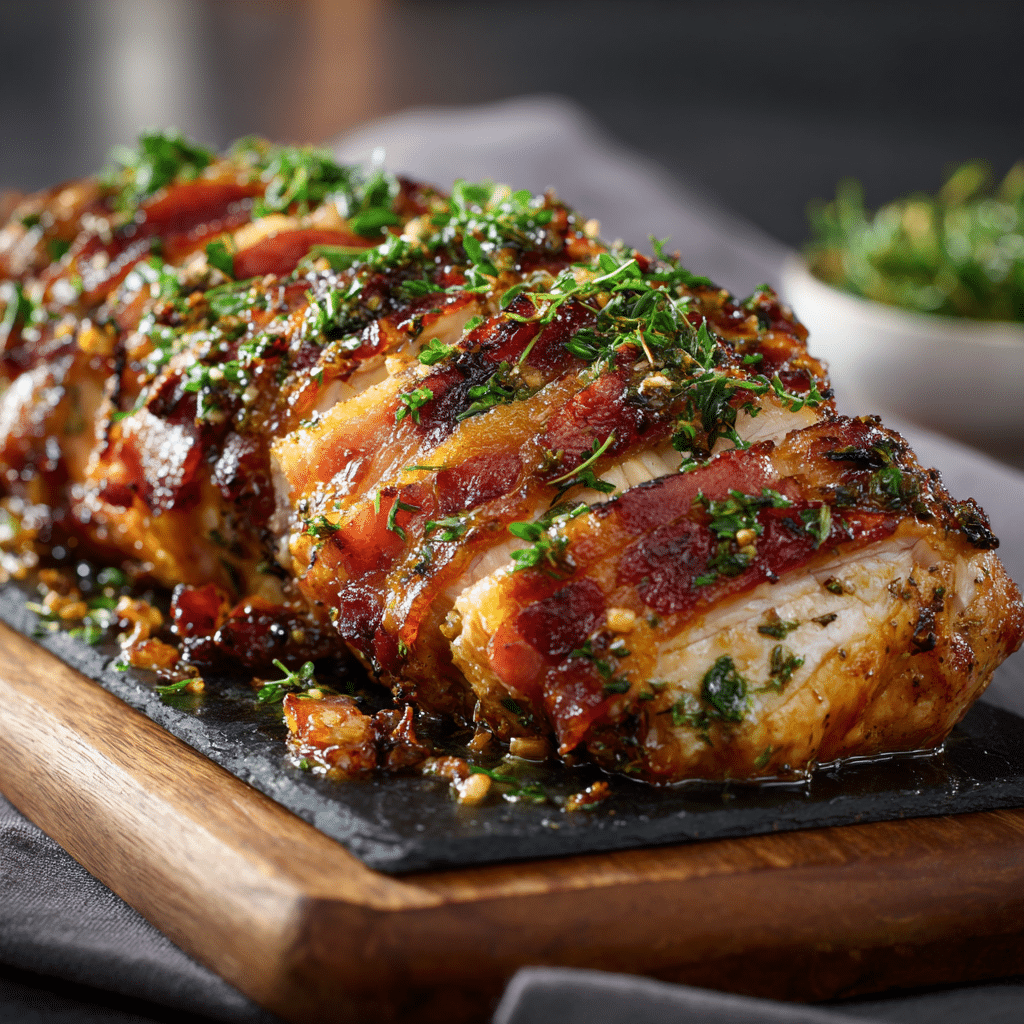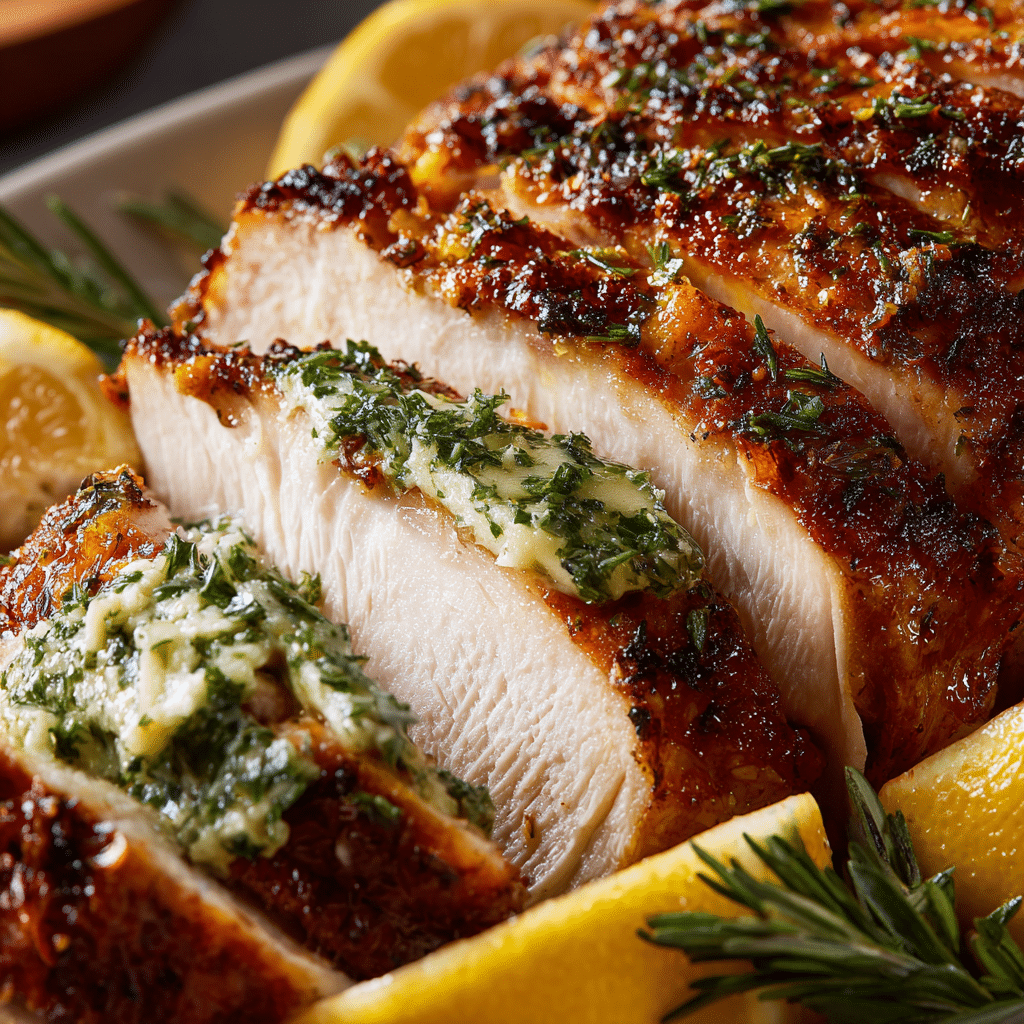When it comes to holiday feasts, few dishes command the spotlight like a perfectly roasted turkey. Yet many home cooks worry about one thing: dry meat. The secret? A rich, flavorful herb butter that locks in moisture while delivering savory depth in every bite. In this guide, you’ll discover the key techniques to achieve a juicy roast turkey with herb butter, from selecting the right roasting temperature to learning professional tricks for keeping the bird tender. We’ll also cover Gordon Ramsay’s famous turkey method, what to put inside for maximum flavor, and two foolproof ways to avoid a dry turkey. By the end, you’ll have everything you need to roast the juiciest turkey your guests have ever tasted.
Looking for inspiration beyond turkey? Don’t miss our holiday main course recipes.
Why Herb Butter Makes a Difference
How Herb Butter Penetrates Meat
Herb butter isn’t just for flavor it’s a moisture shield. When you rub butter under the turkey’s skin, the fat slowly melts during roasting, seeping into the breast and thigh meat. This keeps the lean parts of the bird from drying out, which is one of the biggest challenges in roasting turkey. Because butter is rich in fat, it conducts heat gently while carrying the aroma of herbs deep into the meat.
Flavor and Moisture Benefits
Herbs like rosemary, thyme, sage, and parsley blend beautifully with butter, infusing the turkey with an earthy, aromatic flavor. Combined with garlic and lemon zest, the result is a bird that’s fragrant and full of depth. The butter also helps the skin crisp up into a golden, flavorful crust. What you end up with is the best of both worlds: juicy meat on the inside and crispy skin on the outside.
The Secret to a Moist Turkey
The Role of Fat, Baste, and Brine
The biggest enemy of turkey is dryness, and the solution lies in fat and moisture. Herb butter adds fat directly under the skin, but you can boost juiciness even more by brining. A wet brine (soaking the turkey in a saltwater solution with herbs and spices) helps the meat absorb moisture, while a dry brine (rubbing the bird with salt and herbs) improves texture and flavor without extra water.
Basting brushing or spooning the turkey’s juices over the skin during roasting adds flavor and shine, though it won’t rehydrate dry meat. Instead, think of it as a flavor enhancer.
Avoiding Overcooking & Internal Temperature Control
Even the best butter won’t save an overcooked turkey. The key is monitoring internal temperature. Turkey breast dries out faster than dark meat, so aim for 165°F (74°C) in the thickest part of the breast and 170–175°F (77–79°C) in the thigh. Use a meat thermometer to check regularly. If parts of the bird finish earlier, you can tent them with foil to prevent overcooking while the rest roasts.
By combining fat (herb butter), brining for added moisture, and precise temperature control, you’ll unlock the secret to a moist, flavorful turkey every time.
Keeping a Turkey Moist While Roasting

Basting, Tents, and Drip Pans
One classic way to keep turkey moist during roasting is basting. Every 30–40 minutes, spoon pan drippings over the bird to recycle its own flavorful juices. However, basting also means opening the oven door, which can lower temperature and slow cooking, so balance is key.
Another technique is using a foil tent. If the breast browns too quickly, loosely cover it with aluminum foil. This prevents the skin from burning while allowing the meat underneath to cook gently.
Finally, a drip pan filled with broth or wine under the turkey helps keep the oven humid, reducing the risk of the bird drying out.
Using Butter Under the Skin & in the Cavity
For maximum juiciness, don’t just coat the turkey on the outside spread herb butter under the skin directly on the breast and thighs. As the butter melts, it bastes the meat from within.
You can also place a few tablespoons of butter (or even herbed compound butter) inside the cavity along with aromatics like onion, garlic, and lemon. This ensures that flavor and fat circulate as the turkey roasts, giving you both moist meat and rich drippings for gravy.
By layering fat, moisture, and steam, you create a roasting environment that keeps turkey succulent from the first slice to the last.
Best Temperature for a Juicy Turkey
Ideal Roasting Temperature Zones
The best way to achieve a juicy turkey is to roast it at a moderate, steady temperature. Most chefs recommend 325°F (163°C) for a balance of even cooking and moisture retention. At this temperature, the skin becomes golden and crispy without drying out the breast meat.
For smaller turkeys (under 12 pounds), some cooks prefer 350°F (177°C) to speed things up, while larger birds benefit from the lower, slower roast at 325°F to ensure the inside cooks before the outside dries out.
Using a Meat Thermometer & Checking Doneness
Forget the old “time per pound” rule internal temperature is what counts. Insert a meat thermometer into the thickest part of the breast and thigh, avoiding bone. A turkey is perfectly done when the breast reaches 165°F (74°C) and the thighs register 170–175°F (77–79°C).
Once out of the oven, let the turkey rest for at least 20–30 minutes before carving. Resting allows juices to redistribute throughout the meat, preventing them from spilling out when sliced. This single step is one of the easiest ways to guarantee a juicy turkey.
What to Put Inside or Under the Turkey to Keep It Moist
Herbs, Aromatics, Butter, and Stuffing
What you place inside your turkey can dramatically affect both flavor and moisture. Instead of stuffing the cavity tightly with bread stuffing which can prevent even cooking opt for moisture-boosting aromatics:
- Onion halves, garlic cloves, and celery for savory depth.
- Lemon or orange wedges for brightness.
- Fresh herbs like rosemary, thyme, and sage for classic holiday flavor.
To boost juiciness further, place a few tablespoons of herb butter inside the cavity. As the turkey roasts, the butter melts and bastes from within.
Loosening the Skin and Applying Butter
Another crucial step is applying butter under the turkey’s skin. Gently loosen the skin over the breast and thighs with your fingers, being careful not to tear it. Spread a thick layer of herb butter directly onto the meat. This ensures that the leanest part of the turkey the breast gets extra fat and flavor protection during cooking.
Some cooks also like to place thin slices of butter-soaked cheesecloth or even strips of bacon over the breast, which slowly release fat and keep the turkey moist throughout roasting.
By thoughtfully layering aromatics inside and butter beneath the skin, you’ll add both flavor and juiciness that elevates your turkey to a show-stopping centerpiece.
How Gordon Ramsay Keeps the Turkey Moist

His Butter-Under-Skin Method & Use of Bacon Drip
Gordon Ramsay is famous for his holiday turkey technique, and it all starts with herb butter under the skin. He mixes softened butter with garlic, lemon zest, and herbs, then massages it directly onto the breast meat. This infuses flavor and adds a protective fat layer to keep the lean meat juicy.
Another signature Ramsay move is draping the turkey breast with layers of bacon before roasting. As the bacon cooks, its fat slowly drips into the turkey, adding moisture and flavor while preventing the breast from drying out. The bacon is removed toward the end so the skin crisps up beautifully.
His Tips on Resting and Checking Doneness
Ramsay emphasizes two other critical steps:
- Resting the turkey: After roasting, he insists on letting the bird rest for at least 45 minutes. This allows juices to redistribute, keeping the meat tender when carved.
- Checking doneness properly: He avoids guessing and relies on a thermometer, ensuring the turkey breast reaches the perfect 165°F (74°C).
By combining butter under the skin, bacon draping, and careful resting, Gordon Ramsay’s method guarantees a turkey that’s both succulent and packed with flavor.
Two Proven Ways to Prevent Dry Turkey
Brining vs Dry Rub + Fat Layering
One of the most effective ways to keep turkey moist is brining. A wet brine soaking the bird in saltwater with herbs and spices helps it absorb extra moisture before cooking, which locks in juiciness. For those who prefer less mess, a dry brine (coating the turkey in salt and letting it rest in the fridge) achieves similar results by breaking down muscle fibers, making the meat tender and flavorful.
Alongside brining, fat layering is another moisture-preserving trick. This includes butter under the skin, herb butter in the cavity, or even laying bacon or cheesecloth soaked in butter over the breast. These fat layers melt during roasting, basting the turkey naturally.
Slow Roasting Methods & Covering
Another proven method for juicy turkey is slow roasting at lower heat. Cooking at around 325°F allows the meat to cook evenly without drying out. For extra insurance, cover the turkey with foil during the first part of roasting, then remove it later to crisp the skin.
Some cooks also use a roasting bag, which traps steam and moisture around the bird. While it may not give the crispiest skin, it almost guarantees a moist turkey.
By combining brining with fat layering, or slow roasting with covering, you have two foolproof strategies to ensure your turkey is juicy every single time.
Step-by-Step Juicy Roast Turkey with Herb Butter Recipe

Ingredient List & Preparation
Here’s a tried-and-true recipe for a juicy roast turkey with herb butter, perfect for Thanksgiving or any festive occasion:
| Ingredient | Amount | Notes |
|---|---|---|
| Whole turkey (12–14 lbs) | 1 | Fresh or thawed |
| Unsalted butter (softened) | 1 cup (2 sticks) | Base for herb butter |
| Fresh rosemary | 2 tbsp, chopped | Classic aromatic |
| Fresh thyme | 2 tbsp, chopped | Adds depth |
| Fresh sage | 2 tbsp, chopped | Holiday flavor |
| Garlic cloves | 4, minced | For bold aroma |
| Lemon zest | From 1 lemon | Brightens flavor |
| Onion | 1, quartered | Aromatic for cavity |
| Lemon | 1, halved | Moisture & freshness inside cavity |
| Carrots & celery | 2 each, chopped | Base for roasting pan |
| Olive oil | 2 tbsp | Helps browning |
| Salt & black pepper | To taste | Seasoning |
Preparation:
- Preheat oven to 325°F (163°C).
- Pat turkey dry with paper towels.
- Mix softened butter with herbs, garlic, lemon zest, salt, and pepper.
- Loosen skin over breast and thighs with fingers, spread half the herb butter directly onto the meat under the skin.
- Rub remaining butter over the turkey’s skin.
- Stuff cavity with onion, lemon halves, and fresh herbs.
Cooking, Resting, Carving
- Place carrots and celery in the roasting pan to act as a flavorful rack. Set turkey on top.
- Roast uncovered at 325°F, basting occasionally with pan juices.
- If breast browns too quickly, tent loosely with foil.
- Cook until breast reaches 165°F and thighs 170–175°F.
- Remove from oven, cover with foil, and rest for 30 minutes.
- Carve by removing legs and thighs first, then slicing breast meat against the grain.
This method guarantees a flavorful herb butter crust, golden crispy skin, and moist, juicy meat that’s holiday-ready
Troubleshooting & Pro Tips
What to Do if Turkey Turns Dry
Even with the best preparation, sometimes turkey can still come out a bit dry—especially the breast. Don’t panic! You can rescue it by:
- Slicing thinly and drizzling with warm turkey stock or gravy to restore moisture.
- Mixing dry turkey into soups or casseroles for a second life.
- Serving with extra herb butter or compound butter that melts over slices for added juiciness.
Adjustments for Different Sizes or Ovens
No two turkeys or ovens are alike. Here are tips to adapt:
- Small turkeys (under 12 lbs): Roast slightly hotter (350°F) to avoid overcooking.
- Large turkeys (18+ lbs): Stick to 325°F and allow plenty of time. Consider covering with foil for the first half.
- Convection ovens: Lower temperature by 25°F compared to conventional ovens.
- Crowded ovens (with sides cooking at the same time): Expect roasting time to be longer, so always trust the thermometer, not the clock.
Pro Tips for Foolproof Juiciness
- Dry brine 24 hours ahead for incredible flavor penetration.
- Use a digital meat thermometer for accuracy.
- Let turkey rest covered in foil—never carve straight from the oven.
- Prepare extra herb butter to melt over carved slices for bonus flavor and shine.
With these troubleshooting tricks and expert tips, you’ll have the confidence to serve a perfectly juicy roast turkey with herb butter even if a few surprises pop up along the way.
FAQs About Juicy Roast Turkey with Herb Butter
What is the secret to a moist turkey?
The secret is a combination of fat, moisture, and temperature control. Using herb butter under the skin provides a fat layer to keep the breast juicy, while brining adds internal moisture. Most importantly, don’t overcook—use a meat thermometer to check doneness.
How do you keep a turkey moist while roasting?
Spread herb butter under the skin, baste occasionally with pan juices, and tent the breast with foil if it browns too quickly. Adding aromatics and butter inside the cavity also helps lock in moisture as the bird roasts.
What is the best temperature for a juicy turkey?
Roasting at 325°F (163°C) is ideal for most turkeys. Cook until the breast reaches 165°F (74°C) and the thigh registers 170–175°F (77–79°C). Always check with a meat thermometer instead of relying on cooking time alone.
What to put in your turkey to keep it moist?
Fill the cavity with aromatics like onion, garlic, lemon, and fresh herbs. Add a few tablespoons of herb butter inside for extra moisture. Avoid dense bread stuffing, which can slow cooking and dry out the bird.
How does Gordon Ramsay keep the turkey moist?
Gordon Ramsay rubs herb butter under the skin, drapes bacon over the breast to baste with fat, and insists on a long resting period after roasting. He also uses a thermometer to ensure perfect doneness.
What are two ways to keep turkey from drying out?
Two proven methods are brining (wet or dry) and fat layering (butter under the skin, bacon, or cheesecloth). Both approaches lock in moisture and flavor while preventing overcooking.
Conclusion
A juicy roast turkey with herb butter is more than just a centerpiece—it’s a holiday tradition done right. By layering butter under the skin, filling the cavity with aromatics, and roasting at the right temperature, you can lock in flavor and moisture from start to finish. Whether you try Gordon Ramsay’s bacon-draped version, use a classic brine, or keep it simple with just herb butter, the key is balance: fat, seasoning, and careful cooking. With these techniques, your turkey will come out golden on the outside, tender on the inside, and unforgettable at the holiday table.
Looking for more holiday ideas? Check out Thanksgiving recipes or discover our best gravy recipes.

